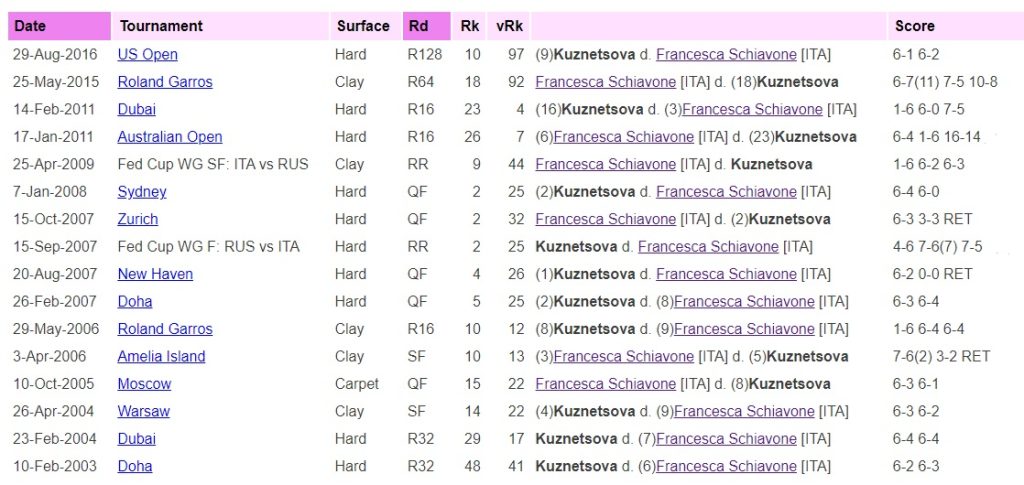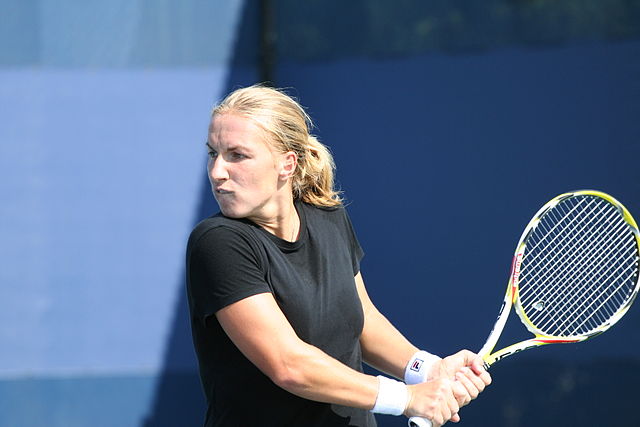
In 2022, I’m counting down the 128 best players of the last century. With luck, we’ll get to #1 in December. Enjoy!
* * *
Svetlana Kuznetsova [RUS]Born: 27 June 1985
Career: 2002-present
Plays: Right-handed (two-handed backhand)
Peak rank: 2 (2007)
Peak Elo rating: 2,192 (3rd place, 2007)
Major singles titles: 2
Total singles titles: 18
* * *
The two longest matches of the 2011 season lasted exactly four hours and 48 minutes each. At the Australian Open, David Nalbandian outlasted Lleyton Hewitt in the first round, 3-6, 6-4, 3-6, 7-6(1), 9-7. At the US Open, Juan Carlos Ferrero beat Gaël Monfils, 7-6(5), 5-7, 6-7(5), 6-4, 6-4. There were 17 five-setters that reached the four-hour mark that year, including the US Open final between Novak Djoković and Rafael Nadal.
The third longest match of 2011 wasn’t one of those five-setters. No, it was a fourth-round women’s match at the Australian Open. Svetlana Kuznetsova and Francesca Schiavone battled for four hours and 44 minutes before Schiavone came out on top, 6-4, 1-6, 16-14. It was the second-longest WTA match in history, behind only the wacky 1984 contest with the 643-shot rally.
The Melbourne marathon had everything. 80 deuces, 50 break points, and 17 breaks of serve–over 1,800 shots by the time it was done. Both women even serve-and-volleyed–Schiavone led that category by doing it twice. To say it was topsy-turvy would be a bit like calling Isner-Mahut “long.” The contributor who logged the match (all 358 points of it!) for the Match Charting Project noted at the 4:25 mark, “Both players starting to look a bit tired.”
The Kuznetsova-Schiavone head-to-head is one of the wilder subplots of 21st century women’s tennis.
Kuznetsova won 10 of the 16 meetings, but Schiavone snuck off with half of the six three-setters. Sveta won the first of their epic clashes in the 2007 Fed Cup final. Four years after their meeting at the 2011 Australian Open, they did it again, going to 10-8 in the third in Paris. That match didn’t quite clear the four-hour mark, but like the gutbuster in Melbourne, it had just about everything else.
Kuznetsova’s history against her Italian rival represents her career in miniature. She has enjoyed the occasional triumph in between struggles with inconsistency. She has fought out one slugfest after another, losing many of them by the smallest of margins. Most of all, she has played lots and lots of tennis.
* * *
Ironically, both of Kuznetsova’s victories in major finals were rather tidy affairs. At the US Open in 2004, she outplayed Elena Dementieva, 6-3, 7-5, and at the French in 2009, she defeated Dinara Safina, 6-4, 6-2. Both opponents had their own internal demons to grapple with, and Sveta took advantage.
It was rarely that simple. The Spring after her US Open victory, she suffered a sequence of near-misses that would’ve sent lesser competitors into early retirement. At Indian Wells, she lost to Dementieva, 7-5 in the third. In Miami, she fell to Ana Ivanović, 7-5 in the third. A month later in Warsaw, she beat Kim Clijsters but lost in the final to Justine Henin–you guessed it–7-5 in the third. Another month down the road at Roland Garros, she lost another three-hour heart-breaker to Henin. You don’t need me to tell you what happened from 5-all in the third set.
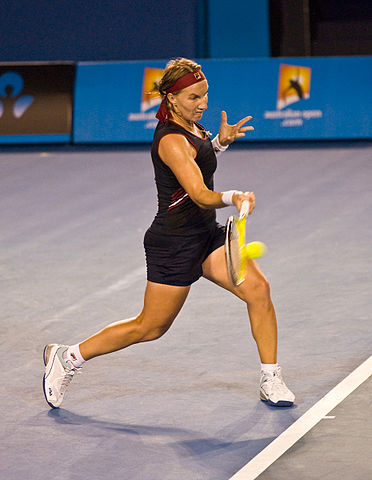
She bounced back to reach the Wimbledon quarter-finals, but when it came time to defend her US Open title, her nerves could no longer keep up. In Flushing, she lost to 97th-ranked Ekaterina Bychkova in straight sets, making her the first female US Open champion to lose the following year in the first round. Her ranking, which had reached a career-best number four in August, careened back out of the top ten.
Her defense of the 2009 French Open title was nearly as punchless. Her entire 2010 clay court campaign lasted seven matches, including first round exits in Rome and Madrid to Maria Kirilenko and Shahar Peer, respectively. (Both were in three sets, but the Peer match ended 6-0.) At Roland Garros, she reached the third round only to lose once more–in three sets, of course–to Kirilenko. Her ranking had climbed back to number three after winning the 2009 Beijing title, but with the French Open points gone, she fell out of the top ten again.
Kuznetsova’s peak came in between the two slam titles, when she reached number two on the WTA computer (and 3rd on the Elo list) in late 2007. She won the US Open warmup in New Haven in the strangest way possible: a three-setter over Agnieszka Radwańska and then three victories by retirement. In the season as a whole, she won 17 of her 24 deciding sets. Unfortunately, two of the seven losses came at the year-end WTA Tour Championships in Madrid. She failed to win a match against the elite field, falling to Ana Ivanović by a score of (what was that again?) 7-5 in the third.
* * *
I trust that you’ve noticed a pattern. In 2009, Pete Bodo called Sveta “a complicated young lady who never met a match she couldn’t choke away.” That isn’t quite right, even if it has sometimes felt that way. She is plenty complicated, to be sure, and she has a knack for making any match she played as complicated as she is–often emerging through the muddle as an exhausted winner.
Here are the active leaders in three-set matches played:
Player Deciders Wins Losses Svetlana Kuznetsova 355 215 140 Venus Williams 306 187 119 Angelique Kerber 271 152 119 Alize Cornet 261 140 121 Petra Kvitova 254 149 105 Sara Errani 251 125 126 Anastasia Pavlyuchenkova 246 133 113 Serena Williams 236 170 66 Vera Zvonareva 234 137 97 Karolina Pliskova 208 131 77
These numbers might be off by a couple of matches here and there–they may include the occasional ITF or a misclassified retirement or two. If you look up the results using Tennis Abstract’s filters, you’ll get slightly different records. But the margins here are so big that the details don’t matter. Kuznetsova has played way more three-setters than any other active player. She tops the list in both wins and losses as well.
It’s a bit surprising, given all of the Russian’s memorable defeats, that her winning percentage is so high, at 61%. She’s just a tick behind Venus Williams (also 61%), and the only other women on this list who win their three-setters at a higher rate are Serena Williams (72%) and Karolína Plíšková (63%). Jelena Janković, who had a great deal in common with Kuznetsova, also played more than 300 three-setters in her career but lost more often than she won.
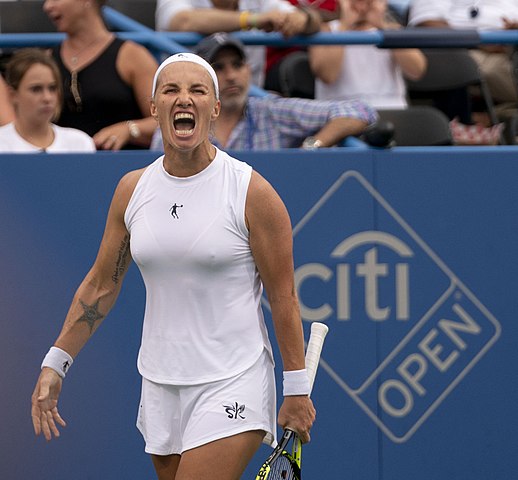
Credit: Keith Allison
Kuznetsova also stands out when we limit our view to the tightest three-set contests. Here are the active leaders in matches that reach 5-all in the decider:
Player 3rd 5-alls Wins Losses Svetlana Kuznetsova 80 46 34 Venus Williams 75 41 34 Serena Williams 56 32 24 Angelique Kerber 54 31 23 Karolina Pliskova 53 31 22 Caroline Garcia 49 33 16 Petra Kvitova 49 27 22 Andrea Petkovic 47 22 25 Varvara Lepchenko 47 20 27 Kristina Mladenovic 45 20 25
In this category as well, Sveta has played more matches than any other active player. She has won more of them, and she’s tied with Venus for the most losses. Again, for all the painful 7-5 defeats, her win rate is respectable. Janković played 78 of these, and she lost more often than she won. Another contemporary with a reputation for circuitous routes from coin toss to handshake, Sam Stosur, won just 24 of 67 matches when they were so close.
* * *
It’s a cliché that tennis players struggle when they think too much. In Kuznetsova’s case, it might be true. She certainly has more going on upstairs than the direction of her next serve.
Journalist Matt Cronin described Sveta as more introspective than the other Russian stars of her generation. He interviewed her in early 2013, when she returned to the tour after a six-month hiatus. Her excitement to come back wasn’t quite wholehearted:
When you play over and over every year the same tournament, the same players, it’s quite difficult. I never feel sick of the game because I love tennis a lot. I have been sick from travel and sick from staying away from home, from my family, from my friends. But I never hated tennis. I love tennis and I enjoy tennis.… But I’ve been watching matches, and I didn’t really feel like I wanted to be out there.
She may have had reservations, but she picked up where she left off. For three years, she played a full schedule, coming through qualifying when necessary and reaching the occasional final. It wasn’t until 2016, after her 30th birthday and more than a decade past her first major title, that she returned to the ranks of the elite.
She started the 2016 season ranked 25th, and quickly made a statement, knocking top seed Simona Halep out of Sydney in three sets. If fans needed any more proof that Sveta was back in all her glory, she turned in another performance for the history books in Fed Cup the next month. She and Richèl Hogenkamp went at it for four hours, the longest match in the competition’s history.
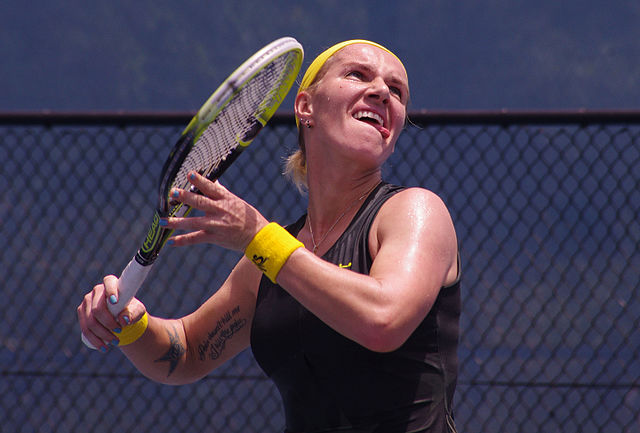
She lost the Hogenkamp match, 10-8 in the third, but she won a whopping 22 three-setters that year. That’s not quite a record–Petra Kvitová won 25 in 2013–but it was by far the most of Kuznetsova’s third-set packed career. One of the third sets got her past world number one Serena Williams in Miami; another put her in the second week at Wimbledon when she beat Sloane Stephens, 6-7(1), 6-2, 8-6. In October, she needed to win the title in Moscow to qualify for the elite year-end championships, and with three-set wins in the quarter-finals and semi-finals, she did just that.
Less than 48 hours after securing the Moscow trophy, she was 5,000 miles away in Singapore, taking on Agnieszka Radwańska in her first round-robin match. She had climbed back into the top ten after more than six years, so she must have felt that she could handle anything–even some unwanted hair in her face.
A newswire reported that she looked to be “on the verge of exhaustion and close to breaking down,” yet she got the better of Radwańska for the 13th time in her career. She went on to beat Karolína Plíšková in a third-set tiebreak, qualifying for the elimination rounds of the season-ending event. In the semi-finals against Dominika Cibulková, she finally ran out of gas, taking the first set 6-1 but dropping the next two. It wasn’t quite the fairy-tale ending she’d hoped for, but it re-established her as a force on the tour, and she remained in the top ten throughout 2017.
Wrist surgery ended her comeback, and she has played a limited schedule since. As recently as the summer of 2019, she flashed the power and persistence that made her a major champion, ousting both Plíšková and Ashleigh Barty to reach the final in Cincinnati. She’s been out of action since Wimbledon last year as she tries to get back in playing shape. A month away from her 37th birthday, a return to the top seems unlikely, but opponents should remain ready for battle. She only won 5 of her 16 matches last year, but half of them went three sets.
